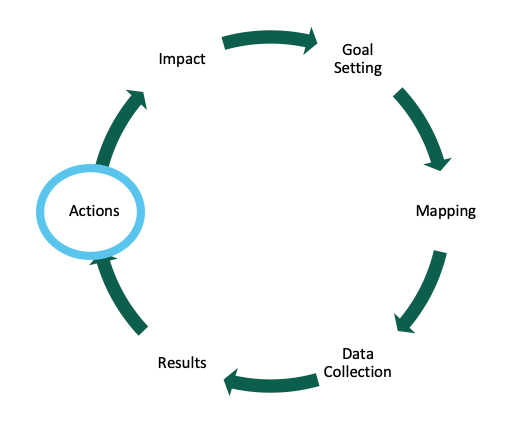
In assessment, actions taken represent the planned changes a program has based on assessment findings from the current cycle. What needs to be changed in order to improve the results?
Once the results have been analyzed and utilized, finding where there are differences between expected targets and benchmarks and where students perform provides an opportunity for programs to reflect on their curriculum map and see the extent that a Student Learning Outcome is being introduced, reinforced, and mastered throughout the curriculum. Further, looking at the degree to which students met, exceeded, or under performed on a Student Learning Outcome can provide important information. If some students did very poorly, but some did very well, and the average of these met the benchmark, there may be areas in the curriculum (like an elective class) where those who did well were provided more information. This provides an opportunity to see whether the content and assignments of a course are actually aligned with the Student Learning Outcomes the course is intended to cover.
Additionally, looking at all aspects of a measure as opposed to the Student Learning Outcome as a whole can provide key context for how to best help the program's students moving forward. For example, if a Student Learning Outcome had three aspects in it which each represented a row in a rubric, it is important to discern whether students performed well on each aspect individually, or if one aspect outshone others. Is there a specific area that can be improved upon within that aspect of the Student Learning Outcome?
Moreover, if the predetermined targets and benchmarks are achieved, it may be time to increase the standard to which the students are held. This may mean that the individual aspect of a rubric might increase (i.e. students are expected to earn X instead of Y in future years) or it may mean that more students are expected to meet the proficiency for that Student Learning Outcome.
Actions taken can be ineffective or effective.
|
INEFFECTIVE
|
EFFECTIVE
|
|
"X amount of students achieved this outcome: no change needed. "
|
"X amount of students achieved this outcome: outcome will be measured again in the 22-23 school year."
|
|
"Faculty will discuss."
|
"At the upcoming faculty meeting, the deficiencies in outcome 3 will be discussed as they relate to course X. The faculty lead will be asked to make changes to lectures leading up to the assignment and incorporate information about Y. Outcome will be measured again in the 22-23 school year."
|
